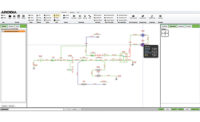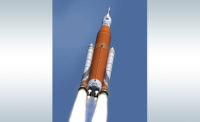China’s railway system is growing by leaps and bounds—and Chinese train manufacturers are growing along with it.
CSR Zhuzhou Electric Locomotive Research Institute Co. Ltd. is one of those manufacturers. Founded in 1959, CSR Zhuzhou has grown into a global company, with facilities in the United States, Britain and Australia. Today, the company’s fields of activity also include electric motors, power electronics, automation, composites and renewable energy.
Just as steam engines were considered the mechanical marvels of their day, today’s high-speed electric locomotives still impress even experienced engineers. In addition to massive electric motors and batteries, modern trains are equipped with myriad sensors, communications gear, computer controls and safety mechanisms.
Designing the wiring system for such a complex assembly is challenging. At CSR Zhuzhou, engineers had reached the limits of the electrical design software they had been using previously.
Although the company’s designers frequently used 3D applications to simulate the wiring between electrical components and create manufacturing documentation, it proved difficult to incorporate changes into the wire harness. The process lacked consistency and integration. For instance, the connection lists had to be adjusted manually, which led to problems when there were extensive modifications.
“The more cables we added to the connection list, the more confusing the product’s 3D model became,” says production processes engineer Ding Zuhui.
Manufacturing drawings were created manually, and material requirements data was first entered by hand into a parts list system and then again into product lifecycle management (PLM) software.
“We needed integration across the wire harness design and the mechanical construction, as well as the ability to show the wire harness data in the mechanical data. Our previous system couldn’t offer that,” says Ding.
CSR Zhuzhou found an answer with Harness proD from EPLAN Software & Service. Harness proD is software for the design and documentation of cables and wire harnesses in 2D and 3D. The software and can import and export mechanical design files from all the major 3D CAD programs, including Solidworks, Solid Edge, Autodesk Inventor, Siemens NX, PTC Creo and CATIA. This enables engineers to design a harness based on actual 3D mechanical data, which helps prevent errors, such as incorrect length calculations or insufficient space.
With Harness proD, CSR Zhuzhou’s engineers can check various aspects of the wire harness, including bending radius, bundle diameter, length limitations and potential conflicts with mounting brackets.
According to Ding, the biggest advantage of Harness proD is that it facilitates concurrent engineering. The software allows harness design to begin in the digital prototype phase of mechanical construction. Many errors that were first recognized only once a physical prototype was created can now be eliminated during the product development process. That saves time and money.
Seamless Integration
Harness proD is part of a suite of computer-aided engineering products from EPLAN. The platform also includes Electric P8 (software for planning, documentation and management of electrical systems), Fluid (CAE for pneumatic and hydraulic systems); PPE (CAE for chemical plants, refineries and other process industries); and Pro Panel (CAE for control cabinets, switchboards and power distribution systems).
“One of our strong points is the interconnectivity between the Electric P8 project management software and Harness proD, which allows you to transfer information about wires, connectors, terminals, tape, loom tubing and other parts back and forth. That’s a major plus for documentation,” says Sergio Brinkhaus, lead applications specialist and certified technical consultant for EPLAN.
Harness proD can also import wiring and parts lists from other sources, such as Microsoft Excel and lists in TXT or CSV formats. Wire details, such as crimp specifications, seals, electrical classes and strip length, are also transferred between systems. Thus, if there’s a change to the harness from either the electrical or the mechanical side, everything is up to date.
All of the company’s software can access the EPLAN Data Portal, which provides online access to product data from more than 125 component manufacturers, including TE Connectivity, Molex, Wago, Schneider Electric, Festo, Bosch Rexroth, Rockwell Automation and Balluff. This data can then be dragged and dropped into system documentation. This reduces configuration work and increases the quality of documentation, since specifications come directly from the supplier and are always up to date.
“There is one parts database for all disciplines, whether it’s fluid power, electrical power or whatever,” explains Brinkhaus. “The idea is to maintain consistency in part information between departments.”
User-Friendly Design
Brinkhaus says Harness proD was designed to be intuitive and user-friendly. For example, engineers can define cable paths by pointing and clicking with a mouse. Design rules check bending radii, cross-section and bundle limitations, and path obstructions. For example, a bend in a cable will turn red if a maximum bend radius has been exceeded during routing. Engineers can correct the problem by clicking and dragging the cable via the mouse.
When the harness design is complete, the software can output full-scale 2D nail board drawings, as well as control files for wire processing equipment. The software also generates all the documentation needed for manufacturing, including bills of materials, cable schedules, and estimates for production time, cost and weight of the harness.
Harness proD also helps engineers manage harness variants. Wire harness options can be managed within a single design, and one or more electrical options can be defined within each variant. Engineers toggle through variants using mouse-driven menus. All the necessary manufacturing documents are automatically generated for all variants.
Systematic design is achieved through modularization and reuse. The foundations for this are the “complex entity,” which can be defined as a group of elements or even a complete wire harness. Once defined, the entity can be stored and reused and exchanged with other project participants.








